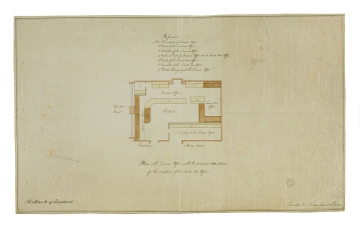Scale
bar scale
Inscribed
as above, The Bank of England (Bailey), plan labelled: Entrance, Publick, Land Tax Office (twice), Income Office, belonging to the Cheque office, Strong Room, Garden / Court, a key No 1 to 7 entitled Reference of desk locations: Principal of Income Office, Desks of the Income Office, Counters of the Income Office, Cashiers Desk for Income Office and Land Tax Office, Desks of the Land Tax Office, Desks belonging to the Cheque Office
Signed and dated
- Lincolns Inn Fields. March 20th 1801
Hand
Soane office
Notes
The office in this drawing is situated at the south-west wing of the Bank, far from the new north-east offices, but it was built in response to the new wing. The Income Office was newly instituted in England in 1799, and the Bank was responsible for its collection. In January 1802 the Bank approved Soane's design for a Land Tax Office 'in order that the apartments may be finished for the use of the Deputy Accountants'. Presumably, then, the previous Land Tax Office was in the north-east of the Bank, but it was moved for the Deputy Accountants office. This office is situated in the south-west corner of the Bank, between the Reduced Annuities Office and the Dividend Pay Office.
Level
Drawing
Digitisation of the Drawings Collection has been made possible through the generosity of the Leon Levy Foundation
Sir John Soane's collection includes some 30,000 architectural,
design and topographical drawings which is a very important resource for
scholars worldwide. His was the first architect’s collection to attempt to
preserve the best in design for the architectural profession in the future, and
it did so by assembling as exemplars surviving drawings by great Renaissance
masters and by the leading architects in Britain in the 17th and 18th centuries
and his near contemporaries such as Sir William Chambers, Robert Adam and
George Dance the Younger. These drawings sit side by side with 9,000 drawings
in Soane’s own hand or those of the pupils in his office, covering his early
work as a student, his time in Italy and the drawings produced in the course of
his architectural practice from 1780 until the 1830s.
Browse (via the vertical menu to the left) and search results for Drawings include a mixture of
Concise catalogue records – drawn from an outline list of the collection – and
fuller records where drawings have been catalogued in more detail (an ongoing
process).


